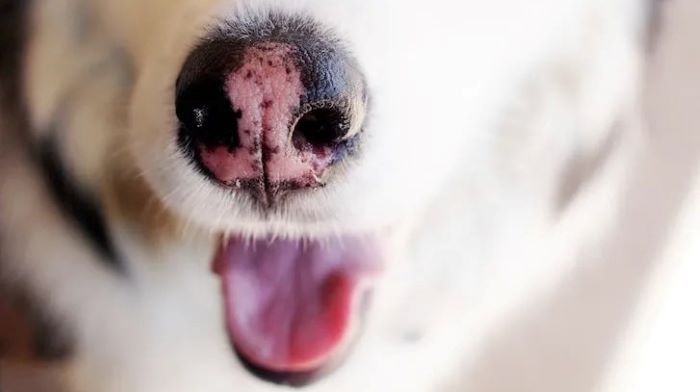If you’re a dog owner, you might have noticed that your dog’s nose color changes to pink over time. It’s a good sign or a bad?
A dog’s nose color is monitored by the number as well as the pigment in its skin cells, which can be impacted by several variables including genetics, age, environment, health, and more.

Normal causes like snow nose, age, or heredity can occasionally cause a dog’s nose to become pink or lose color. At times, a dog’s nose may turn pink or lose color due to major health issues like cancer, autoimmune illness, infection, or damage.
In this blog, we will discuss about “Why does dogs nose turn pink?” Also we will guide you when to see a vet and give you some tips to prevent allergies or irritation in a dog’s nose. Let’s start reading!
Contents
Why Does Dogs Nose Turn Pink?
One of the reasons why some dogs have pink noses is genetics. Genetics determines the amount and distribution of melanin in a dog’s body, which affects their coat, eye, and nose color.
Melanin is a pigment that protects the skin from sun damage and gives it color. There are two types of melanin: eumelanin (black) and phaeomelanin (red).
The default color of eumelanin is black, but it can be modified by genes to create other colors such as liver (brown), blue (grey), or isabella (pale brown). The default color of phaeomelanin is gold or yellow, but it can also vary in intensity from deep red to cream.

1). Dogs Nose Turn Pink Because of The Genetics
Some dogs are born with pink noses or have them change color as they grow older because they have a recessive liver gene that changes the black pigments into liver/pink.
This gene affects not only the nose, but also the coat and eye color.[1] For example, a liver dog will have a brown coat, amber eyes, and a pink nose. Some breeds that have pink noses or are prone to them are:
- Field Spaniel
- Pointer
- English Springer
- Cocker Spaniel
- Dalmatian
- Australian Shepherd
- Siberian Husky
- Nova Scotia Duck Tolling Retriever
These breeds carry the liver gene, which means they can pass it on to their offspring if they mate with another liver dog or a carrier of the gene.
However, not all dogs with pink noses are liver dogs. Some dogs may have a pink nose due to other factors such as sun exposure, allergies, or irritation.
2). Dogs Nose Turn Pink Because of The Sun Exposure
Another reason why some dogs have pink noses is sun exposure. Sun exposure can cause a dog’s nose to fade or lose pigment over time, especially if they have a light-colored or thin coat.
Sun exposure can also lead to sunburn and skin cancer in dogs, which can be painful and life-threatening.
Sun exposure affects a dog’s nose by damaging the melanin-producing cells in the skin. Melanin is the pigment that gives color to the skin, hair, and eyes.
When the melanin-producing cells are damaged by the sun’s ultraviolet (UV) rays, they produce less melanin or stop producing it altogether. This results in a loss of color or a change in color of the nose, as well as other parts of the body.[2]

3). Dogs Nose Turn Pink Because of Allergies or Irritation
Another reason why some dogs have pink noses is allergies or irritation. Allergies or irritation can cause a dog’s nose to turn pink or red due to inflammation of the nasal passages or skin.
Allergies or irritation can also cause other symptoms such as sneezing, itching, watery eyes, and nasal discharge.
Some of the common allergens or irritants that can affect a dog’s nose are:
- Pollen
- Dust
- Mold
- Fleas
- Food
- Chemicals
- Perfumes
- Smoke
These allergens or irritants can trigger an immune response in the dog’s body, which produces histamine and other inflammatory substances.
Histamine and inflammation can cause the blood vessels in the nose and skin to dilate, resulting in a pink or red color.
Signs and Symptoms of Allergic Reaction or Irritation in a Dog’s Nose:

Some of the signs and symptoms of an allergic reaction or irritation in a dog’s nose are:
- Pink or red nose
- Swelling of the nose
- Crusts or scabs on the nose
- Dryness or cracking of the nose
- Nasal discharge (clear, yellow, green, or bloody)
- Sneezing
- Itching
- Watery eyes
- Difficulty breathing
Some of these signs and symptoms may also indicate other conditions, such as infection, injury, tumor, or autoimmune disease.
Therefore, it is important to consult your veterinarian if you notice any changes in your dog’s nose.
When to See a Vet
While most cases of pink nose in dogs are harmless and natural, there are some situations where you should consult a vet if your dog’s nose changes color suddenly or drastically.
This could indicate a serious medical condition that needs immediate attention and treatment.
Some of the possible medical conditions that can cause a dog’s nose to turn pink or lose pigment are:
a) Infection: Infections can cause inflammation and discharge of the nose, which can affect its color. Some infections are canine distemper, leishmaniasis, aspergillosis, and nasal pyoderma.
b) Injury: Injuries can cause bleeding and scarring of the nose, which can affect its color. Some injuries are bites, scratches, burns, or foreign bodies. Some injuries can also lead to infections.

c) Autoimmune disease: Autoimmune diseases can cause the immune system to attack the nose, causing loss of pigment or ulceration. Some autoimmune diseases are DLE, PF, and vitiligo.[3]
d) Cancer: Cancer can cause abnormal growth of cells in the nose, causing ulceration, bleeding, or color change. Some cancers are SCC, MM, hemangioma, and hemangiosarcoma.
Some of the warning signs and symptoms that indicate a serious problem with a dog’s nose are:
- Sudden or drastic change in color
- Persistent or severe bleeding
- Foul-smelling or purulent discharge
- Difficulty breathing or snoring
- Pain or discomfort
- Loss of appetite or weight
- Lethargy or depression
If you notice any of these signs or symptoms in your dog, you should contact your veterinarian as soon as possible for diagnosis and treatment.
Depending on the cause and severity of the condition, your dog may need medication, surgery, or other interventions to restore their nose health.
A dog’s nose can change color for various reasons, some natural and harmless, some serious and harmful.
It is important to monitor your dog’s nose regularly and report any abnormal changes to your veterinarian. By doing so, you can help your dog maintain a healthy and happy nose.
Dogs Nose Turn Pink: Tips to Prevent
The treatment or prevention of allergies or irritation in a dog’s nose depends on the cause and severity of the condition. Some of the possible preventions are:
- Limit your dog’s exposure to direct sunlight, especially during peak hours (10 a.m. to 4 p.m.).
- Provide your dog with shade and plenty of water when they are outdoors.
- Apply sunscreen to your dog’s nose and other sun-sensitive areas of their body, such as the ears, lips, belly, and groin. Use a sunscreen that is specially formulated for dogs or that is safe for human babies. Avoid using sunscreen that contains zinc oxide or para-aminobenzoic acid (PABA), as these ingredients can be toxic to dogs if ingested.
- Reapply sunscreen every four to six hours or more frequently if your dog is playing in the water.
- Check your dog’s nose regularly for signs of sunburn, such as redness, swelling, blisters, peeling, or cracking. If you notice any of these signs, contact your veterinarian for treatment.

- Avoid contact with irritants or allergens that may cause inflammation or irritation of your dog’s nose, such as pollen, dust, mold, fleas, food, chemicals, perfumes, or smoke.
- Consult your veterinarian for any underlying medical conditions that may affect your dog’s nose pigment, such as infection, injury, autoimmune disease, or cancer. Follow your veterinarian’s advice on diagnosis and treatment.
- To treat or prevent allergies or irritation in a dog’s nose, you should identify and avoid the allergen or irritant, use humidifiers or saline sprays.
- Apply soothing creams or ointments, give medications as prescribed by your veterinarian, use immunotherapy or hypoallergenic diet if needed. By doing so, you can help your dog’s nose heal and prevent further complications.
FAQs
Will dogs nose turn black again?
It is due to snow nose, aging, or injury, the nose may turn black again when the season changes, the dog gets older, or the wound heals. However, if it is due to genetics, autoimmune disease, or cancer, the nose may not turn black again and may require veterinary treatment.
How do I fix my dogs pink nose?
If you want to prevent or reduce the color change, you can try to protect your dog’s nose from sun damage by using sunscreen or shade, avoid contact with irritants or allergens that may cause inflammation, and consult your veterinarian for any underlying medical conditions that may affect the nose pigment.
Why is my dog’s nose pink to black?
Your dog’s nose may change from pink to black due to several reasons. Some of them are natural and harmless, such as snow nose, aging, or genetics. Some of them are serious and harmful, such as infection, injury, autoimmune disease, or cancer.
Is it normal for a dogs nose to be red?
A dog’s nose may be red due to various causes. Some of them are normal and benign, such as sun exposure, allergies, or irritation. Some of them are abnormal and worrisome, such as sunburn, infection, injury, or cancer. You should check your dog’s nose for any signs of pain, swelling, bleeding, discharge, or difficulty breathing. If you notice any of these signs, you should contact your veterinarian as soon as possible.
Conclusion
Concluding our blog: Why Does Dogs Nose Turn Pink?
A dog’s nose may turn pink for various reasons, some of which are harmless and some of which may indicate a health problem. Some possible causes are:
- Snow nose or winter nose, a condition where the nose loses pigment due to cold temperature or sunlight exposure. This is common in certain breeds and usually reversible when the season changes.
- Allergies, such as contact dermatitis, which can cause irritation, redness, and swelling of the nose. This can be prevented by avoiding the allergen and treated with antihistamines and steroids.
- Skin cancer, such as squamous cell carcinoma or melanoma, which can cause abnormal growths, sores, or bleeding on the nose. This can be diagnosed with biopsies and treated with surgery, chemotherapy, or radiation.
There are many other reasons, as we have already discussed. So, if you notice your dog’s nose turning pink, you should monitor them for any other signs of illness or discomfort. Further, also consult your veterinarian for a proper diagnosis and treatment plan.
A pink nose may not always be a cause for alarm, but it is better to be safe than sorry when it comes to your dog’s health.
References:
- Brancalion, L., Haase, B., & Wade, C. M. (2021). Canine coat pigmentation genetics: a review. Animal Genetics, 53(1), 3–34.- DOI
- Keep Pets Safe From Sunburn | Pet Talk | VMBS News. (2022, March 11). VMBS News. Retrieved June 16, 2023, from- vetmed
- Canine skin autoimmune diseases. (2023, May 5). College of Veterinary Medicine. Retrieved June 16, 2023, from- Cornell University

Dania is a dog groomer living in California, who loves styling dogs. She often uses dog accessories to keep them distracted while grooming. She is also a dog parent to a Pomeranian, Duke. It’s because of him she is always on a lookout for the best dog foods, toys, other dog accessories, and ways to keep him equipped, healthy and happy.


